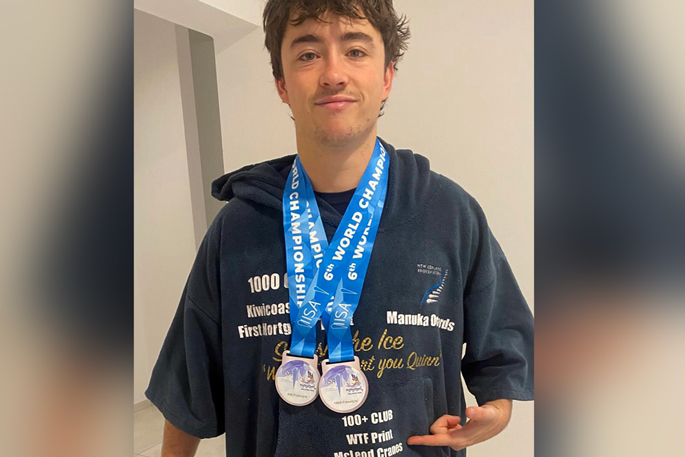An outdoor swimming pool in winter holds little attraction for most people, but for Quinn Boyle, it’s where he is on fire.
Boyle, brought up in Ōtamarākau, was part of the 15-strong New Zealand ice swimming team, the Frozen Ferns, that competed at the sixth World Ice Swimming Championships in Molveno, Italy, earlier this year.
The 19-year-old won silver medals in the men’s 18-24 age group 500m and 1000m and was fifth and sixth overall respectively in the two events.
It was Boyle’s second world championships, having competed in France two years ago.
“I did better in the age groups, but the whole experience was way better. The sport is gaining a bit more professionalism. They are trying to get into the Winter Olympics and it’s definitely getting more official and more well run,” he said.
There is more prizemoney for breaking records and more professionals entered this year’s world championships, creating a higher level of competition.
Different events
Boyle swam in a range of events from 50m up to 1000m and a number of relays.
As someone who has done a lot of open water swimming, including an attempt at swimming Cook Strait in 2022, he said his preference is for the 500m and 1000m events.
Preparation for the 2023 event saw him have regular lengthy ice baths, but this time he only had one prior to the event.
“And it wasn’t that long. I feel like doing all those ice baths ages ago, I don’t really need to do that – I know that I can swim in ice now. It’s more mental, the cold side of things.”
He thinks swimmers can swap to different forms of the sport without much difficulty.
“There’s open water, there’s pool and there’s ice swimming and I think you can transition quite easily. It just comes with a bit of practice.”
Tertiary studies and future events
Now studying agribusiness at Lincoln University in Canterbury, it is an added bonus that he is in the part of the country where the water is cold enough for ice swimming.
This year Quinn wants to focus on another attempt at swimming Cook Strait and will also look at swimming an ice mile.
He is undecided about attending the next world ice swimming championships in two years’ time.
“We’ll see what happens. I enjoy the sport, I really enjoy it, and I like what’s happening with it and it will be exciting to see what happens with it over the next 10 years or so.”
Cold water
Ice swimming involves swimming in water at a temperature of 5C (or less) unassisted, with a silicone cap, pair of goggles and standard swimming costume.
The International Ice Swimming Association has established a comprehensive set of safety and swimming rules together with worldwide swim records.
The temperature in Italy ranged between 1.5C and 2C.
Boyle said he would like to thank the Te Puke and Western Bay of Plenty communities for their support, including the support of “multiple Te Puke businesses”.
“I wouldn’t have been able to go without them. It was huge, the support, because I can’t do that by myself, being a student.”
The Frozen Ferns won more than 50 medals and members broke six world records and the team placed fourth overall.



0 comments
Leave a Comment
You must be logged in to make a comment.